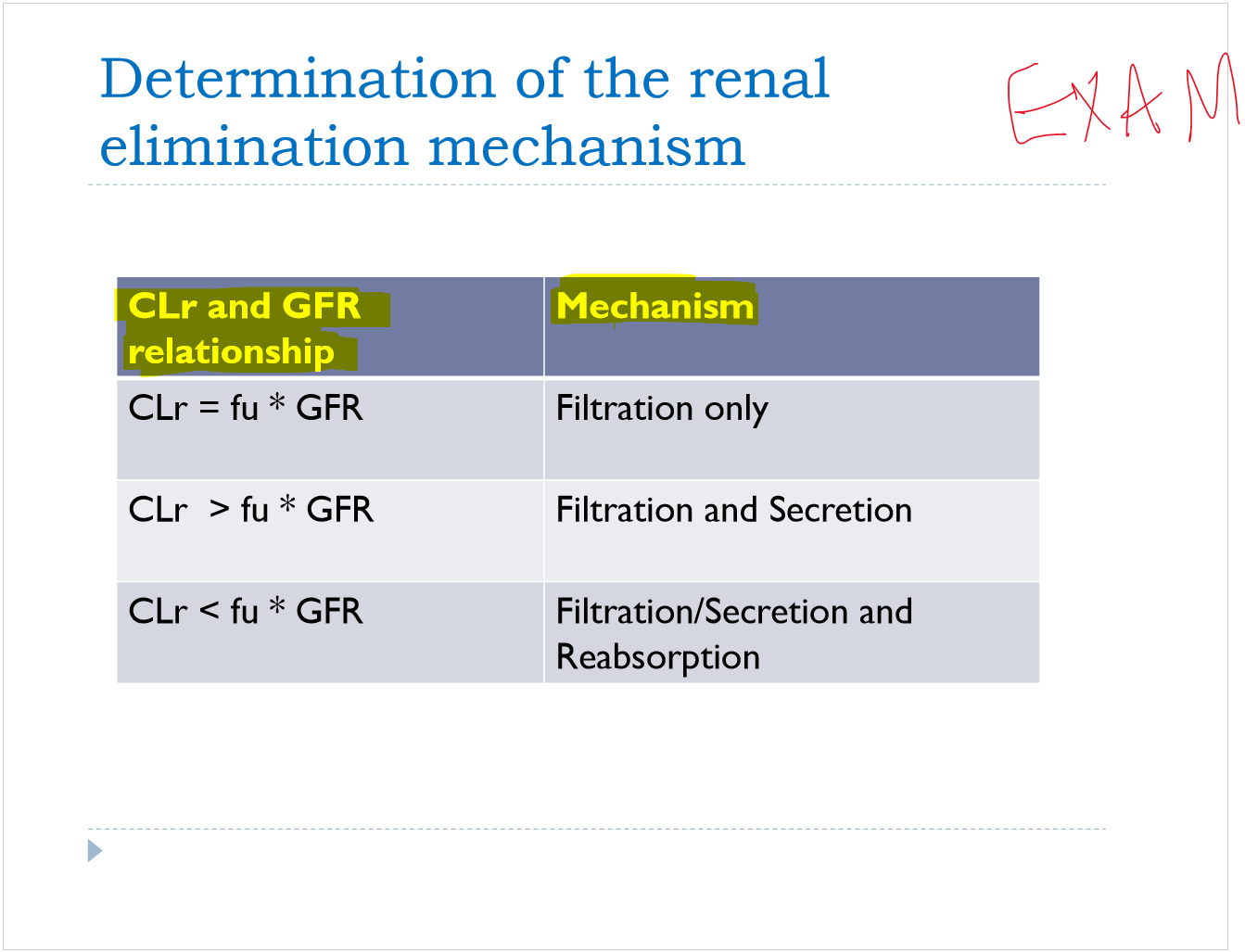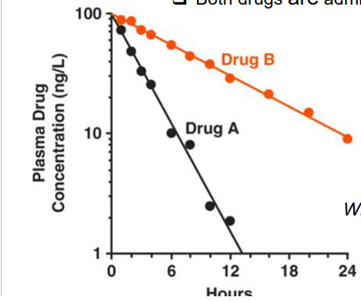FINAL EXAM- MIRZA
1/25
There's no tags or description
Looks like no tags are added yet.
Name | Mastery | Learn | Test | Matching | Spaced |
|---|
No study sessions yet.
26 Terms
Based on the drug clearance data, predict the mechanism of renal excretion.
Drug G: Total CLr= 140 ml/min, CL gf=120 ml/min, Fu=1
a. Filtration only
b. Filtration and Secretion
c. Secretion only
d. Secretion and Reabsorption
b
Relationship between mechanism of renal excretion and drug clearance data:

Clearance for a drug is constant within a patient.
a. True
b. False
a
For the body fluid compartments below, rank them form the lowest volume to the highest.
a. Plasma < ECF < ICF < total body water
b. ECF < ICF < plasma < total body water
c. ICF < ECF < plasma < total body water
d. Total body water < plasma < ICF < ECF
a
If a drug is very well distributed to tissues, its apparent volume of distribution is probably:
a. Large
b. Small
a
If the elimination rate constant is 0.02 h^-1, the percent of drug removed from the body per hour is:
a. 0.02%
b. 0.2%
c. 2%
d. 20%
e. It is impossible to determine
c
In clinical settings, it is common to assume that around 85% of a drug is effectively eliminated after 5 half-lives.
a. True
b. False
b- 95%
In what region of the concentration-response relationship diagram is the probability of adverse effects highest?
a. Therapeutic range
b. Subtherapeutic range
c. Toxic range
d. Potentially toxic range
c
Instantaneous distribution to most body tissues is a characteristic of what model? (I didn’t catch the entire question when he was speaking)
a. One compartment model
b. Two compartment model
c. Multicompartment model
a
One of the key assumptions for a one-compartment IV bolus model is that excretion follows a zero-order kinetic process
a. True
b. False
b-first
The amount of drug per unit of volume is defined as the…
a. Volume of distribution
b. Concentration
c. Clearance
b
The following two concentrations were determined after administration of an IV bolus dose of a drug at time zero. Determine the half-life of the drug. What is Cp0?
C (mg/L) | 18 | 9 |
T (hrs) | 12 | 48 |
t 1/2= 36 hrs
What is the main focus of biopharmaceutics as a science?
a. Dosage regimen
b. Clinical trials
c. Local drug effects
d. Adverse drug reactions
e. Pharmacokinetics and dosage forms
e
What is the pharmacological response of a drug dictated by?
a. Drug concentration at the site of action
b. Dose of drug
c. Volume of distribution of a drug
d. Creatinine clearance
a
Which of the following is the unit for the total body clearance of drug?
a. L
b. Kg/L
c. mL/min
d. mg/L
e. h^-1
c
Which of the following is true regarding the apparent volume of distribution?
a. It is a true volume in which the administered dose is uniformly distributed
b. It relates the amount of drug and the rate of its elimination from the body at a time
c. It is a secondary pharmacokinetic parameter
d. It correlates with the lipophilicity of the drug
d
Which of the following is the most common site used to assess the systemic exposure of drugs?
a. Whole blood
b. Serum
c. Plasma
c
Which of the following is the most common assumption in developing a pharmacokinetic model?
a. The body can be viewed as a single compartment
b. All body tissues are similar
c. All body fluids are similar
d. The plasma concentration reflects the drug body concentration
d
Which of the following drugs is most likely confined to the plasma?
Drug X (Vd= 2L)
Drug Y (Vd= 12L)
Drug Z (Vd= 34L)
a. Drug X
b. Drug Y
c. Drug Z
d. Impossible to predict
a
Which of the following drugs has a longer half-life?

a. Drug A
b. Drug B
b
Which renal elimination process(es) are influenced by protein binding.
a. Filtration
b. Secretion
c. Reabsorption
a
Which of the following drugs has the highest clearance?
| Vd | K |
Drug A | 0.5 | 0.6 |
Drug B | 0.13 | 0.11 |
Drug C | 5 | 0.08 |
a. Drug A
b. Drug B
c. Drug C
c
Creatine clearance is an estimate of which of the following?
a. Hepatic function
b. Active tubular section
c. Effective renal plasma flow
d. Bioavailability
c
The volume of distribution of a drug in a particular patient is constant.
a. True
b. False
a
The volume of distribution of a new drug is 38 L. Which of the following is the most accurate prediction of the drug distribution in the body?
a. It will be confined within the vascular compartment only
b. It will be distributed in total body water
c. It will be distributed to all body tissues
c
Which of the following equations correctly describes renal clearance?
a. CLr= CLGF+ CLTS + TR
b. CLr= CLtotal+ CLTS+ TR
c. CLr= CLGF+ CLTS- TR
d. CLr= CLGF- CLTS- TR
c